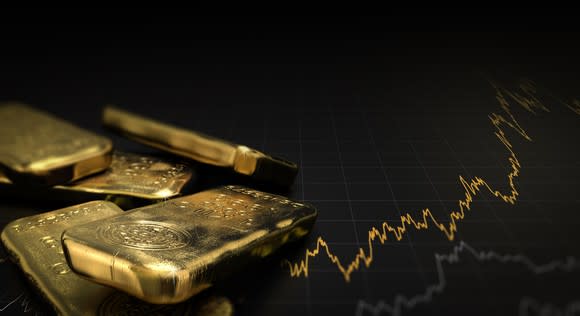Better Buy: Freeport-McMoRan Inc. vs. Wheaton Precious Metals
Stocks are currently in one of the longest bull markets in history. With interest rates rising and trade wars rumbling, a growing chorus of analysts are now openly pondering when the next economic slowdown will occur. While recessions are a natural feature of the markets, even the talk of a sliding stock market seems to increase the popularity of gold as an alternative investment.
That has helped lift the fortunes of various gold miners and streaming companies in the last year, while years of efforts aimed at boosting operational efficiency and financial flexibility are beginning to pay off, too. Investors interested in gold stocks will inevitably come across Freeport-McMoRan (NYSE: FCX) and Wheaton Precious Metals (NYSE: WPM), which boast market caps of $23 billion and $10 billion, respectively. However, the two couldn't be more different -- and that plays a major part in deciding which stock is a better buy.

Image source: Getty Images.
The matchup
Freeport-McMoRan is a traditional gold and copper miner. It conducts exploration, development, and production activities from moving thousands of metric tons of earth around each and every day (quite a bit different from its challenger in this head-to-head matchup, as we'll see below). The company owns interests in mines in North America, South America, and Indonesia, although the bulk of operations -- including 30% of copper production and 99% of gold production expected in full-year 2018 -- are sourced from the island nation.
The high level of dependence on the Grasberg mine in Indonesia was the single biggest concern for investors in the first half of 2018. That's because the national government wanted to own an equity stake of at least 51% to increase the country's financial benefits from the project, and although Freeport-McMoRan agreed to that in principle, details were scarce. That had some investors wondering what would happen if the company had to walk away from the mine altogether.
Luckily, much of the uncertainty was removed on July 12 when the company announced a preliminary agreement to fulfill the Indonesian government's proposal. The new ownership structure will be greatly simplified. Previously, the ownership stakes of the Grasberg mining complex were split between Freeport-McMoRan (54.4%), joint venture partner Rio Tinto (40%), and the government (5.6%). That will change to 48.8%, 0%, and 51.2%, respectively -- assuming the transaction is finalized as planned.
While Freeport-McMoRan will see its share of copper and gold production drop only slightly (its total ownership percentage will drop 5.6%), the sheer size of Indonesian operations makes that consequential for the company's overall output. The company stated that the long-term goal is to replicate the economics of the former joint venture with Rio Tinto by 2022 and to retain that new structure through 2041, but the recent stock performance suggests investors aren't willing to wait around that long. That's likely related to the expectation for 2019 production from the mine to be greatly reduced as operations shift to new expansion areas.

Image source: Getty Images.
Instead of doing the dirty work of mining, Wheaton Precious Metals is a streaming company. It agrees to purchase a percentage of a mine's output at a fixed price, and for a fixed price sells the precious metals back into the market, then sits back with its feet up and watches the cash flow pile up. It's an inherently low-cost, high-margin business model -- and much less risky than the upstream work of mining. But why stop at gold and silver?
Wheaton Precious Metals has recently announced new streaming agreements to diversify its portfolio and position itself for a clean energy future. That includes a streaming agreement with Vale S.A. for cobalt (an important metal in certain lithium-ion battery chemistries) to start in 2021. At current market prices (which are historically high, to be fair) the deal would generate $75 million in cash flow per year.
It followed that up with a new streaming agreement for gold and palladium (an important platinum group metal used in catalytic converters and certain hydrogen fuel cells) from Sibanye-Stillwater. The deal began on the first day of July 2018 and will boost Wheaton Precious Metals' annual gold production by 14,500 ounces, in addition to providing over 27,000 ounces of palladium per year.
Diversifying into strategically important metals for the 21st century is a bold move that should prove lucrative for shareholders. Considering the streaming company converted 34% of revenue into net income and 63% into operating cash flow in the first quarter of 2018, the new foray into cobalt and platinum group metals should add a healthy amount of incremental earnings and cash flow.

Image source: Getty Images.
By the numbers
As it turns out, the difference between business models matters a great deal to investors. That's because gold mining stocks generally have not managed to beat the returns of the S&P 500 over long periods of time -- not even when dividends are included.
Unfortunately, Freeport-McMoRan is not an exception: Shares have posted three-year total returns of just 1.1%, compared to 40.7% for the S&P 500. On the other hand, gold streaming stocks perform a lot better than their mining-focused peers. Case in point: Wheaton Precious Metals stock has delivered three-year total returns of 62.5%.
The baked-in, high-margin growth tends to place a premium value on shares of streaming companies, however, which is clearly evident in this side-by-side comparison of the two stocks:
Metric | Freeport-McMoRan | Wheaton Precious Metals |
|---|---|---|
Market cap | $23 billion | $10 billion |
Dividend yield | 1.1% | 1.6% |
Forward P/E | 10.2 | 29.9 |
EV/EBITDA | 5.6 | 18.8 |
Data source: Yahoo! Finance.
While premium valuations for streaming stocks can lead to negative surprises if an asset has to be written off (see: Royal Gold in early 2018), companies generally do a great job of diversifying streaming agreements to mitigate risks. Wheaton Precious Metals is no different, boasting annual production of 385,000 ounces of gold and 25 million ounces of silver. Soon it'll churn out 27,000 ounces of palladium (beginning in 2019) and 2.1 million pounds of cobalt (beginning in 2021) per year, too. If a portion of the extra cash flow is reinvested in new streaming agreements, as it has been over the years, then the level of diversification should continue to rise with time.
The better buy is...
Given the major differences in long-term stock performance between gold miners and gold streaming companies, and specifically the divergence between the two companies in this matchup, I think it's pretty clear that Wheaton Precious Metals is the better buy. Sure, it trades at a healthy premium relative to its peer, but its profitability is never in doubt and its new diversification into clean-energy metals, such as cobalt and platinum group metals, provide exciting opportunities for long-term-minded shareholders.
More From The Motley Fool
Maxx Chatsko has no position in any of the stocks mentioned. The Motley Fool has no position in any of the stocks mentioned. The Motley Fool has a disclosure policy.

 Yahoo Finance
Yahoo Finance 